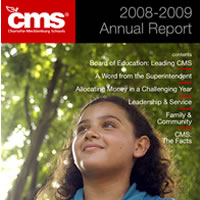If your printing budget has been slashed as a result of budget cuts, you can still communicate effectively with parents and other key publics: Information that’s contained in brochures, annual reports, newsletters, curriculum guides, Realtor packets, and other print materials may be moved online successfully — without resorting to PDFs.
The new annual report from North Carolina’s Charlotte-Mecklenburg Schools (CMS) offers a case in point. Posted online (www.cms.k12.nc.us [1]), the report highlights the previous year’s major accomplishments and financial data.
While the content is fairly standard annual report fare, the format is not. Making strategic use of the web’s interactive capabilities, the report includes short video news clips and interviews, as well as eMail links to people who can provide more information or answer additional questions.
The accountability and assessment section of the report, for example, links to the district’s robust online data dashboard, which offers tools for comparing student achievement and other data by school, demographic group, and geographic region as well as district-wide.
Messages from the superintendent and school board chairperson are pithy and concisely written, and they’re provided in video as well as text formats. The finance section includes some nice charts that clearly show where the money comes from and where it goes–something that’s often hard for district officials to communicate, given the complexity of most public school budgets.
As with accountability and assessment, the Board section repackages existing CMS web site content in the annual report, a cost-effective–and nifty–way to get web users to look at important information that might not generate much traffic on its own.
The most compelling video snippets in the report include news-type stories about the district’s strategic staffing initiative and other efforts to get the right teachers and principals to the schools with the most disadvantaged students.
Embedded in the annual report, these video stories help vividly illustrate how CMS is tackling a national issue in new, creative, and effective ways. A lengthy print tome, no matter how well-researched and well-written, simply wouldn’t have the same impact.
“The purpose of the annual report was to provide a comprehensive view of the district’s success, challenges, finances, and academic achievements,” says LaTarzja Henry, executive director of communications for CMS. “Before we created the annual report, people would have to go to multiple places online or search multiple documents to access this information. We didn’t have it gathered in one place.”
The report’s drill-down features (providing a headline with a link to more information, and so on) make it easy for web users to spend as much time–or as little–as they want.
“Readers can spend anywhere from 15 minutes to an hour or more going through the report,” says Henry. “We strategically designed the report so readers could get both a surface and an-depth look at the district’s performance.”
While increasing transparency and improving constituents’ access to information were the district’s primary goals, CMS also realized significant savings by publishing and distributing the information online rather than in print. With 17,000 employees and more than 135,000 students, the district would have had to reduce the report’s content and narrow the audience significantly to be able to afford the printing and distribution costs.
The first of its kind for CMS, the annual report will serve as a model for future online publications, according to Henry, who used an outside firm to help design and program it for the online environment.
Like many school systems nationwide, CMS’ information technology department is “overworked and understaffed,” says Henry. “We needed a team that could exclusively dedicate time to produce the district’s first interactive report.”
While shifting from print to online information distribution makes sound economic sense, school officials should expect some push-back from constituents who either don’t believe tax dollars should be spent on communication efforts or who are concerned about those who don’t have internet access.
It certainly doesn’t hurt, and is part of our role as school leaders, to remind employees, parents, and community stakeholders that public schools can’t thrive without the support of the public, and a steady flow of information and meaningful opportunities for involvement in school and district decision-making are required to keep the public in our public schools.
School leaders also should keep the latest Pew Internet and American Life research regarding the internet at their fingertips. Updated frequently, these data show that 74 percent of all U.S. adults are now online and that 62 percent of those online now use the internet to view video content.
While the Pew research is helpful and the data are representative nationwide, this doesn’t mean the same statistics will hold true for your local community, however.
Knowing the preferred and most trusted information channels for each stakeholder group is an important part of communications planning, so before you start creating your own online annual report, do a little homework on your local community first. That said, CMS’ online annual report offers an excellent model to emulate.
Award-winning eSN columnist Nora Carr is the chief of staff for North Carolina’s Guilford County Schools.
Note to readers:
Don’t forget to visit the Successful Video Production resource center. Knowing how to produce, edit, and distribute video gives high school and college graduates a valuable and much-in-demand skill. Go to: Successful Video Production [2]
